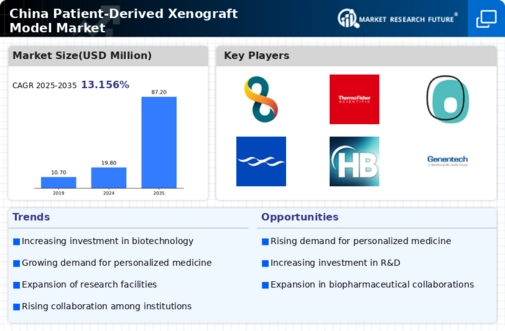Increasing Cancer Incidence
The rising incidence of cancer in China is a critical driver for the patient derived-xenograft-model market. As cancer cases continue to escalate, the demand for innovative treatment options intensifies. According to the National Cancer Center of China, cancer is the leading cause of death, with an estimated 4.6 million new cases reported in 2020. This alarming trend necessitates advanced research models, such as patient derived xenografts, to facilitate the development of targeted therapies. Thus, this market is positioned to grow as researchers seek to understand tumor biology and test new drugs effectively.. The increasing focus on personalized medicine further amplifies this demand, as patient derived models provide insights into individual responses to therapies, potentially improving treatment outcomes.
Advancements in Biotechnology
Technological advancements in biotechnology are propelling the patient derived-xenograft-model market forward in China. Innovations in genetic engineering, cell culture techniques, and imaging technologies enhance the efficacy and reliability of xenograft models. These advancements enable researchers to create more accurate representations of human tumors, which is essential for drug testing and development. The biotechnology sector in China has seen substantial investment, with the market expected to reach approximately $200 billion by 2025. This influx of funding supports the development of sophisticated patient derived models, which are crucial for understanding cancer progression and treatment responses. As the patient derived-xenograft-model market evolves, these technological improvements are likely to play a pivotal role in shaping research outcomes and therapeutic strategies.
Regulatory Framework Enhancements
Enhancements in the regulatory framework surrounding biomedical Market Research Future are influencing the patient derived-xenograft-model market positively. The Chinese government has implemented policies aimed at streamlining the approval process for new therapies and research models. These regulatory improvements facilitate faster access to patient derived xenograft models for researchers, thereby accelerating the pace of innovation in cancer treatment. The National Medical Products Administration (NMPA) has been actively working to create a more conducive environment for clinical trials and research, which is likely to benefit the patient derived-xenograft-model market. As regulations become more favorable, the market may experience increased participation from both domestic and international stakeholders, further driving growth.
Growing Investment in Cancer Research
The surge in investment for cancer Market Research Future is a significant driver for the patient derived-xenograft-model market. Government initiatives and private sector funding are increasingly directed towards oncology research, with the aim of improving treatment modalities and patient outcomes. In 2021, the Chinese government allocated over $1 billion to cancer research initiatives, reflecting a commitment to combat this pressing health issue. This financial support fosters the development of patient derived xenograft models, which are essential for preclinical testing and understanding tumor behavior. As funding continues to grow, the patient derived-xenograft-model market is expected to expand, providing researchers with the necessary tools to innovate and advance cancer therapies.
Rising Awareness of Precision Medicine
The growing awareness of precision medicine among healthcare professionals and patients in China is a vital driver for the patient derived-xenograft-model market. As the healthcare landscape shifts towards personalized treatment approaches, the need for models that accurately reflect individual patient tumors becomes increasingly apparent. Educational initiatives and outreach programs are enhancing understanding of the benefits of precision medicine, leading to greater acceptance and demand for patient derived xenograft models. This shift is supported by a broader trend towards individualized therapies, which are projected to account for over 50% of oncology treatments by 2030. Consequently, The patient derived-xenograft-model market will thrive as it aligns with the evolving preferences of both clinicians and patients..


















Leave a Comment